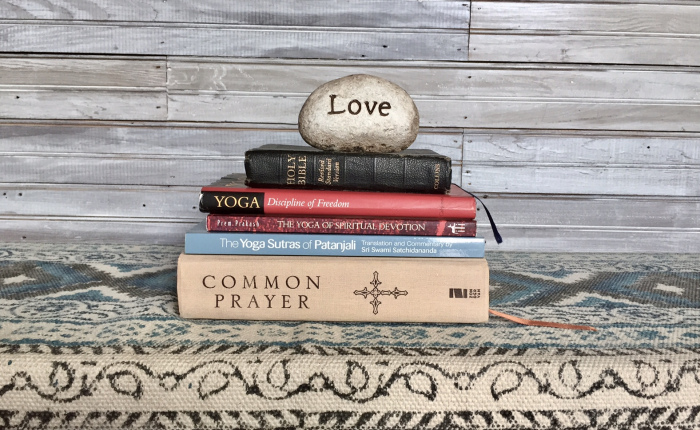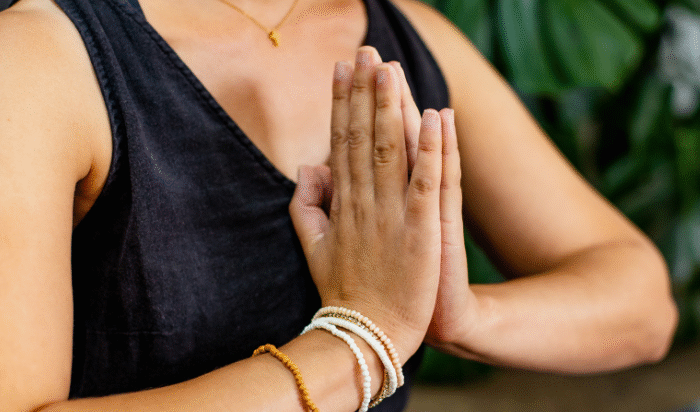Jesus and Yoga
But in your hearts revere Christ as Lord. Always be prepared to give an answer to everyone who asks you to give the reason for the hope that you have. But do this with gentleness and respect, keeping a clear conscience, so that those who speak maliciously against your good behavior in Christ may be ashamed of their slander. 1 Peter 3:15-16
And so I begin the task of explaining how and why I have reconciled my practice of yoga with my Christian faith… My hope is to answer honestly and intelligently for all interested to know how a Christian can keep a clear conscience while practicing a spiritual discipline that was birthed in a culture that was predominately Hindu. I recognize that this is a sensitive subject. I enter the conversation with care, gentleness, and respect. I do not intend to argue or convince anyone to agree with my convictions. I do, however, believe that I am responsible for being prepared to answer this question, and to give a researched account of how and why I believe yoga to be a biblically sound practice for a Christian.
The topic of Christians practicing yoga is controversial with arguments from both the Christian and Hindu perspectives. I will try my best to address the primary concerns as I understand them for both sides of the argument. This is the first in a two-part blog post where I will speak primarily to concerns from Christians using Christian texts. In my second of the two-part blog post I will try to address the concerns, as I understand them, from the Hindu perspective. To begin, we must first answer the basic question what is yoga by examining its purpose and practice?
What is the purpose of yoga?
To prepare the body and mind for meditation with the intention of encountering the presence of God within.
What does the practice of yoga involve?
The yoga of ancient times consisted of solely breath and meditation practices with the intention of communing with the Divine. The postures were developed later as a means of enhancing the capacity of the body and mind so that a person could sit in meditation for long periods with as few distractions as possible. Thus, modern yoga is made up of three pillars: breathwork (pranayama), postures (asana), and meditation (dhyana).
Through these three pillars, one is able to cultivate the state of Samadhi (Communion with God). Though not the ultimate goal of a yoga practice, Samadhi is the primary tool used for the purpose of achieving Moksha or Kaivayla (freedom or liberation). Through Samadhi, one experiences communion with God and is given new perspective of the true nature of the universe enabling them to walk in freedom through life. (Chapters 1 & 4, The Yoga Sutras of Patanjali)
Some say that Kaivayla is Samadhi in action, I would translate this to “Freedom is a life lived through communion with God.”
So the practice of yoga, from a Christian viewpoint, is the practice of communing with God which can enable one to live free from the power of sin and death. (John 15:14; 2 John 1:9; 1 John 2:27-28; Galatians 2:20)
Is yoga a religion?
The short answer to this question is no. Yoga is not a religion; Yoga is a spiritual practice or discipline. However, much of the confusion that surrounds this question is due to the fact that the practice of yoga was birthed through a culture steeped in Hindu philosophy. The ancient yoga texts were influenced by the Hindu philosophy and often describe the discipline of yoga from a Hindu worldview. While it is true that a Hindu practicing yoga will understand the concept of “communing with God” differently than a Christian practicing yoga due to their differing points of view, one does not need to be a Hindu to practice yoga. Much like chanting, fasting, prayer, service, and the study of scripture, the discipline of yoga can be practiced within different worldviews and in varying belief systems.
Can the physical practices of yoga be separated from the spiritual aspect of yoga?
Technically, the answer to this question is yes, the use of Mantra, prayer, and meditation techniques can be omitted from a yoga practice. However, I would quickly follow up with the question “why would you want to do that?” Asana, the physical practice of yoga, was expressly designed to prepare the body and mind to experience the presence of God. When practiced within a Christian worldview, practitioners are seeking communion with the Holy Spirit who dwells within. In this state of communion (referred to as Samadhi) the practitioner is no longer consumed by external realities (“the world”) but instead is absorbed by the presence of God (the things that are above). (Colossians 3:1-3)
Separating physical and spiritual aspects of a yoga practice could be likened to separating the physical and spiritual aspects of kneeling down to pray. While you may be strengthening and stretching the muscles of the lower body while getting up and down from the kneeling position, without the spiritual aspect of the practice, you would miss out on the sweet and powerful benefit, of actually entering into a conversation with God through prayer.
Can Christians practice secular yoga?
In any learning situation, I believe it is important for the student to be aware of who their teachers are and what beliefs they hold.
This does not mean that Christians should not receive instruction from non-Christians, (or vice versa) but that as Christians, we must cultivate discerning minds. To practice discernment, we must first be knowledgeable about our own faith and sacred text, the Bible. Only when we are knowledgeable about what we believe to be true, are we able to recognize something as untrue. Aristotle says, “It is the mark of an educated mind to be able to entertain a thought without accepting it.” Believers are to have “educated minds”. We are to learn with eagerness and to examine the Scriptures to see if what we are being taught is true. (Acts 17:11)
All truth is GOD’s truth, and God is in the business of revealing his truth in the world. Christians are meant to practice discerning God’s Truth at all times as part of our witness in the world. Paul demonstrates this skill of discernment in his sermon on Mars Hill. He had carefully observed the Greek religion and examined their worship. He was familiar with Greek literature and was able to quote Greek poetry containing God’s Truth to the people of Athens at the Council of the Areopagus. It is through Paul’s discernment and his ability to speak Christ into the Greek culture that “some joined Paul and believed.” (Acts 17:22-34)
As Christians, I believe that we are to follow Paul’s example when encountering other beliefs and faith traditions. It is my great delight when I hear biblical Truth- regardless of the source. It is the voice of the Good Shepherd reminding me of the wonderful and surprising ways that He is working in this world. I see it as my great joy and privilege to be able to speak Christ into the philosophies & psychologies that accompany a traditional yoga practice!
When practicing in a non-Christ centered yoga class, I start by setting my intention and saying a prayer that my yoga practice would be honoring and acceptable in God’s sight. I pray that God would make himself known to all that are truly seeking. I ask God to reveal his love to my teacher, my classmates, and/or my students. I ask Him to show me opportunities where I may share the love of God as demonstrated in Jesus Christ with those who are seeking. While listening for God’s truth, I am careful not to participate in chanting of scriptures or mantras that I believe might conflict with my Christian faith. Instead, I might quietly meditate on a bible verse or the lyrics of my favorite hymn.
For me, practicing yoga in a secular context becomes a form of intercession, or moving prayer, asking that God’s love would be revealed in Christ and that His kingdom would come and his will would be done on earth as it is in heaven.
By practicing yoga postures am I worshipping Hindu gods?
No. True, authentic, worship entails much more than physical posture alone. Worship is a state of the heart. Only as we turn our hearts towards Jesus in Spirit and Truth may we truly worship our Father in heaven. (John 4) While physical posture may enhance our worship (i.e. kneeling in prayer, lifting our hands in praise), one cannot enter into worship through physical posture alone.
Repeatedly, scripture shows us that true worship is not mere outward action but requires the proper intention of the heart. In the Old testament, Isaiah warns the Israelites about their meaningless and empty sacrifices, worship, festivals & feasts, prayers, and fasts. God considers the Israelite’s worship an abomination and accuses them of trampling in His courts. (Isaiah 1:10-17; 58) Similarly, in the New Testament, Jesus warns his followers that being consumed only with keeping God’s commands and studying His word is not “true” worship; something is still lacking. (Matthew 15:1-20) King David points us to the missing piece in Psalm 51:
Open my lips, Lord, and my mouth will declare your praise. You do not delight in sacrifice, or I would bring it; you do not take pleasure in burnt offerings. My sacrifice, O God, is a broken spirit; a broken and contrite heart you, God, will not despise.
The outward action of worship is only righteous when the inward state of the heart is in its proper place. It is not through the posture of the body that one enters into worship, but through the posture of the heart. Entering into a yoga posture will not automatically cause you to worship the Hindu mythological character that the pose was named after, just as kneeling down in prayer will not cause you to worship the biblical God. It is only through a fully penitent heart, broken with sorrow over sin that our worship becomes true and acceptable in God’s sight.
So why is there confusion?
As previously stated, the practice of yoga was originally comprised of breath and meditation with the intention of communing with the Divine. The postures were later developed solely for the purpose of preparing the body and mind for meditation. In fact, the Sanskrit word Asana, literally means “to find a firm and steady seat” illustrating that the purpose of these postures was to enhance meditation by helping the mind and body to get still. The physical postures were never intended to be postures of worship.
Still, some Christians fear that by practicing yoga postures, they may unknowingly be worshipping Hindu gods and breaking God’s command to have “no other god before Him”. (Deuteronomy 5:6-7)
While we have already addressed the nature of true, authentic, worship above, we can (and should) investigate further into the postures and the meaning of their names, to discern if there is anything that may conflict, or converge, with Biblical truth.
Most postures were named after animals and objects and often broken down further into numbers (one, two and three) and characteristics of the pose (upward, downward). However, there are a handful of postures that were named after mythological sages and deities of the Hindu faith. What are we to make of the names of each posture?
When we enter into the warrior poses (Virabhdrasana I, II, & III) are we worshipping the Hindu warrior Virabhadra, whom the poses are named after? When we enter into mountain pose (Tadasana) are we worshipping the mountains?
“The myths behind the asanas are intended to serve as inspirational guides that can enhance our yoga practice, fueling it with a deeper, meditative quality.” (Myths of the Asana, 2010)
The stories and myths that accompany each posture carry symbolic meaning enabling a yoga practice to not only work the body, but also to work on the mind or psyche. Much like the parables of Jesus, the wisdom found in these myths are meant to teach a deeper truth, illustrating a moral or spiritual lesson that helps us to have a deeper understanding of ourselves and our connection to the world in which we live. However, one does not need to engage with Hindu mythology to benefit from the symbolic nature of yoga postures.
For example, when entering Tadasana (mountain pose), Christians can meditate on Jesus as the firm foundation of God that supports and holds them. We are reminded that those who trust in God cannot be shaken. We can reflect and ask ourselves if we are building every part of our lives on the love of God that is Christ.
Those who trust in the Lord are like Mount Zion, which cannot be moved, but abides forever. As the mountains surround Jerusalem, so the Lord surrounds his people, from this time forth and forevermore. Psalm 125:1-2 ESV
When entering the warrior postures, named after the Hindu warrior Virabhadra, Christians can meditate on the strength of God and remember that their true strength comes from Him alone. (Isaiah 40:28-31 & 41:10) We become mindful that we can do all things through Christ who strengthens us (Philippians 4:13) and can draw on this strength to battle our own sinful thoughts and actions. As Christians, we become aware that we harbor a spiritual warrior within, the Holy Spirit, who is ready to help us to fight the temptations of this world and enable us to surrender our imperfect wills to the perfect will of God. (Matthew 26:39, Mark 14:36, Luke 22:42, John 6:38)
When we look at the meanings and symbolism behind each asana, Christians may find that these myths complement biblical truth and give us a fresh perspective on God’s Word. (For more ideas, I have created the Postures of Prayer: a Christian yoga deck to help Christians to find meaning in the some common yoga postures.)
Is the practice of yoga beneficial to the Christian? Will yoga clearly help me in my walk with Christ? Is yoga an active good?
I do not believe the practice of yoga to be inherently good or evil. A better question might be “Can God be glorified through the practice of yoga?”
I believe this question can be answered individually for Christians in different settings as God convicts the heart of each believer according to the works that He has prepared in advance for them. For example, a believer in India practicing yoga taught by an instructor who is teaching a Hindu mantra in Sanskrit may be convicted by the Holy Spirit differently than a believer in the United States practicing yoga postures, breath, and meditation techniques at a local, studio, gym, or YMCA.
When we look to Scripture, we can find some similar situations concerning circumcision (Acts 15) and the consumption of meat which had been sacrificed to idols. (1 Corinthians 8 & 10) The early church was divided regarding how to handle these issues while under the new covenant of God, which is faith in Christ.
In the case of circumcision, Paul denounced the practice for Gentile Christians, claiming that every man who accepts circumcision is… severed from Christ and has fallen away from grace. (Galatians 5:3-4) But, interestingly, it is Paul who personally circumcises Timothy, whose mother was Jewish and whose father was Greek. In this single instance, Paul was convinced that circumcision would be beneficial and would help further the kingdom by removing a stumbling block that could impede the Jews ability to accept the gospel of Jesus Christ. (Acts 15 & Romans 3:1-2) Here we see that believers can be convicted differently in various situations according to God’s specific purpose.
Similarly, Paul establishes that there is nothing inherently sinful about eating meat that has previously been involved in a feast ceremony, although he emphasizes that Christians should be careful to avoid participating in the feasts themselves. Paul also warns the early Christians that they should never violate their conscience, nor should they encourage an activity that may cause another Christian to stumble. (Romans 14:1-23) In essence, Paul is making it clear that, in Christ, we are free from the law to glorify God and grow His kingdom by carrying out the work that He has prepared for us in advance.
Though I am free and belong to no one, I have made myself a slave to everyone, to win as many as possible. To the Jews I became like a Jew, to win the Jews. To those under the law I became like one under the law (though I myself am not under the law), so as to win those under the law. To those not having the law I became like one not having the law (though I am not free from God’s law but am under Christ’s law), so as to win those not having the law. To the weak I became weak, to win the weak. I have become all things to all people so that by all possible means I might save some. I do all this for the sake of the gospel, that I may share in its blessings. 1 Corinthians 9:19-23
My journey with Jesus (and yoga)
It is not my intention to convince others to share my conviction. I wish to simply share my story and encourage others to seek God’s Word and godly counsel on the subject of practicing yoga as a Christian.
Personally, I have spent much time in study and prayer over my yoga practice as a follower of Christ. I have sought the counsel of my pastor, my elders, my accountability group, and my husband. I have not glazed over the controversy that surrounds Christians practicing yoga. I have put my practice of yoga on the altar of God. I believe that God has given yoga back to me for the purposes of deepening my relationship with Jesus and showing me what it means to truly ABIDE in Christ.
Furthermore, I believe that God has given me innumerable opportunities to talk about the Love of God, which is Christ, from my yoga mat. Here are some examples of how God is using my practice of yoga to bring him glory and to build his Kingdom.
- God opened the doors for me to teach Christ based yoga classes
- He gave me the opportunity to teach “yoga through the lens of Christ” at Montreat college
- He enabled me to teach and write curriculum for YogaFaith, a Christ- based yoga teacher training recognized by the Yoga Alliance
- He inspired me to create The Postures of Prayer: a Christian yoga deck
- He has given me a passion for creating Getting Still Studios, a website for Christian prayer beads and a Christ-centered yoga studio
- He inspired me to create an online training and mentoring program to help people to understand the practices and philosophies of yoga from a Christian worldview.
I have enjoyed sweet communion with the Holy Spirit in my yoga practice, and I have been given the privilege of sharing the love of Jesus in my yoga classes. God has entrusted me with the gift of teaching other Christians what it means to ABIDE in Christ and move with the Holy Spirit. He has drawn me deeper into study and meditation on His Word. He has opened my eyes to just how amazing our God is and how big His plans are for blessing all nations! Through my study of the ancient philosophies and teachings of yoga, God has shown me over and over again that He truly is, El Elyon, the most High God, and that He is in the business of revealing himself in this world! (Genesis 22:18 & 14)
Soli Deo Gloria! (To God alone be the glory)
Amen
Want to learn more about “Christ-centered” yoga? Get your FREE guide here, grab your spot in my signature course Yoga for Christians, or join me for a Christ-centered yoga class in my online studio and get started learning today!

Grow in Godly wisdom and wonder…
From Bible studies and book clubs to rich topics like Christ-centered yoga, meditation, energy work, prayer practices, and more—our studies are designed to deepen your faith, broaden your understanding, and nurture your soul.
Join the waitlist for exclusive discounts and to be the first to know when our next study opens!






